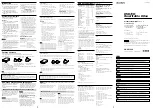
5.1.3 Calculation of Brake Resistance
To ensure that the frequency converter does not cut out for safety reasons when the motor brakes, the resistance value is selected on the basis of the
peak braking effect and the intermediate circuit voltage:
Bbr
=
U
DC
2
P
peak
Ω
It can be seen that the brake resistance depends on the intermediate circuit voltage (UDC).
With frequency converters that have a mains voltage of 3 x 380 - 480 Volt, the brake will be active at 770 Volt (UDC).
You can also choose to use the brake resistance recommended by Danfoss (R
REC
). This is a guarantee that the frequency converter is able to brake at
the highest braking torque (M
BR
). The recommended brake resistance can be seen from the ordering table for brake resistors.
R
REC
calculated as:
Brec
=
U
DC
2
x
100
Pmotor
x
Mbr
( % )
x
η
motor
x
η
inv
Ω
NB!
Remember to check that the brake resistance can manage a voltage of 850 Volt, if Danfoss brake resistors are not being used.
η
motor
is typically 0.90 and
η
INV
is typically 0.98. For 400 Volt, R
REC
at 160%
braking torque can be written as:
400
volt
Brec
= 420139
Pmotor
Ω
NB!
The minimum brake resistance selected should have an ohmic value no more than 10% lower than that recommended by Danfoss.
If
a lower brake resistance is selected there is a risk of overcurrent, which can destroy the unit.
5.1.4 Calculation of Braking Power
When calculating the braking power, it must be ensured that the mean
and peak powers can be dissipated to the brake resistor. The mean power
is determined by the period time of the process, i.e. for how long the
brake is applied in relation to the period time of the process. The peak
power is determined by the braking torque, which means that during
braking the brake resistor must be able to dissipate the energy input. The
figure shows the relation between mean power and peak power.
5 All About FCD 300
VLT
®
Decentral FCD 300 Design Guide
120
MG.90.S1.02 - VLT
®
is a registered Danfoss trademark
5
















































